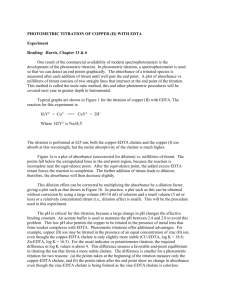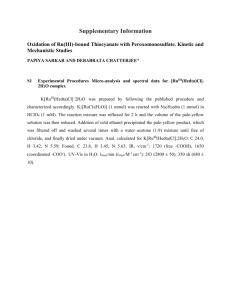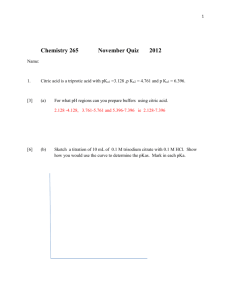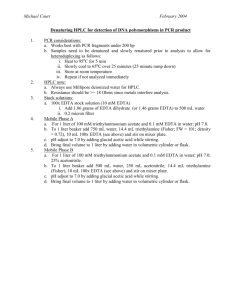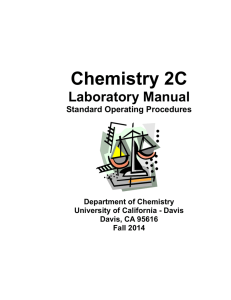Experiment #3 – Photometric Titration
advertisement
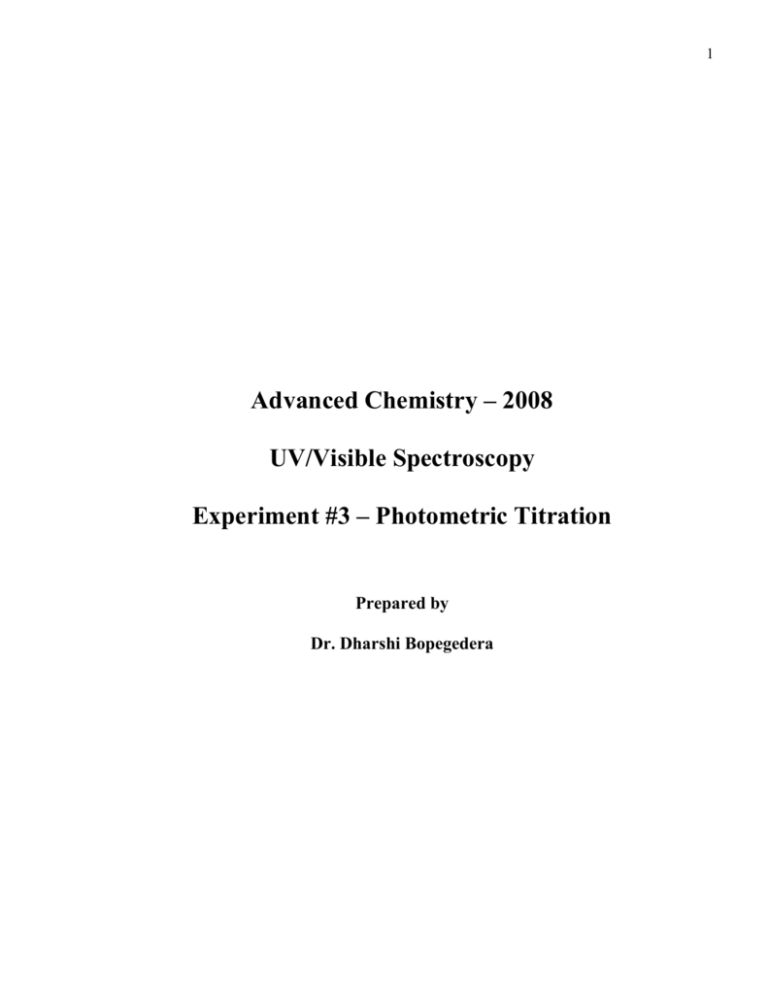
1 Advanced Chemistry – 2008 UV/Visible Spectroscopy Experiment #3 – Photometric Titration Prepared by Dr. Dharshi Bopegedera 2 PHOTOMETRIC TITRATION Chemicals, Glassware and Equipment Needed: 10 ml burettes (2) 50 ml burettes (2) 3 funnels 10 mL volumetric pipette 25 mL volumetric pipette one 100 ml volumetric flask two 50 ml volumetric flasks pipette bulbs distilled water 100 ml beaker with Parafilm to cover it Pasteur pipettes 4 spatulas 250 ml beaker with Parafilm to cover it burette stand with clamp EDTA (ethylenediaminetetraacitic acid – disodium salt) Ca(NO3)2 (hydrated salt) Cu(NO3)2 (hydrated salt) Conc. NH4OH solution NH4Cl 50 mL graduate pipette Quartz cuvettes End points of titrations are often detected with the aide of an indicator. This method can be quite limiting at times, particularly if the titration is carried out for the detection of multiple species in the analyte. Under such circumstances photometric titration methods could be used quite effectively by making use of the differences in molar absorptivity coefficients of the various species present (at the selected wavelength) in the analyte. A photometric titration curve is a graph of absorbance as a function of the volume of the titrant. The appearance or disappearance of an absorbing species will give a linear (concentration dependent) change in absorbance, resulting in two straight lines that intersect at the equivalence point. The selection of the analytical wavelength requires much care, because there are at least 3 species that may be absorbing light: the original substance, the titrant, and the product(s). The usual procedure is to select some wavelength at which only one species will absorb. However, the mere fact that only one species will absorb at a particular wavelength does not necessarily mean that it should be selected for the analysis. This is because, if the absorbance is very intense, the %T readings may be limited to the undesirable 0% – 20% region, where comparatively large errors in measuring absorbance would overshadow the inherent accuracy of the photometric titration. Theory: For a successful photometric titration it is necessary that the measured species adhere roughly to Beer’s law, and the necessary chemical and instrumental precautions must be taken to maintain the relationship A = cl Where A = absorbance = log I0/I I0 = intensity of incident radiation I = intensity of transmitted radiation = molar absorptivity coefficient or molar extinction coefficient c = concentration in mol/L or M l = path length in cm 3 Beer’s law also applies to a medium containing more than one kind of absorbing substance, provided there is no interaction between them. In such a case: Atotal = A1 + A2 + A3 + A4 + …… = 1 c1 l + 2 c2 l + 3 c3 l + 4 c4 l + …… Some typical photometric titration curves are given below for the reaction X + T = P where T = titrant, X = analyte, P = Product(s) of reaction A A A Volume of titrant Case II Volume of titrant Case I A A Volume of titrant Case IV Case I Case II Case III Case IV Case V Case VI = = = = = = Volume of titrant Case III A Volume of titrant Case V Volume of titrant Case VI X and P both absorb X and T both absorb Only T absorbs One (or more) of the products P absorbs P and T absorb and T > P P and T absorb and T < P Case II offers the greatest degree of accuracy due to the acute angle of interaction, which facilitates locating the equivalence point. 4 Procedure: Prepare the following solutions. Use the same analytical balance for all chemicals. All groups must use the same balance and the same UV/vis spectrometer for the entire experiment. Otherwise you cannot compare your results. EDTA Solution - 50.00 ml of 0.250M EDTA (ethylenediaminetetraacetic acid – disodium salt) Unknown Solution - Weigh out the required amount of Ca(NO3)2 (hydrated salt) and the required amount of Cu(NO3)2 (hydrated salt) into a 50 ml volumetric flask. The required amounts are given in the table below. Record the exact weights of the copper and calcium salts. Be sure to use the analytical balance to weigh and record your weights to the nearest mg. Add distilled water to dissolve and make up to the mark with distilled water. This is your “unknown solution”. Buffer Solution - Weigh out 5.4 g of NH4Cl and 35.0 ml of conc. NH4OH solution into a 100 ml volumetric flask. Make up to the mark with distilled water. This is your buffer solution. Note that the weights given below are the “dry weights”. You need to calculate how much of the hydrated salt will be required to get these dry weights of each of the salts. Groups Ca(NO3)2 Cu(NO3)2 1 2 3 4 5 0.97 g 0.97g 1.94 g 0.97 g 1.46 g 0.97 g 1.94 g 0.97 g 1.46 g 0.97 g Weight of hydrated Ca(NO3)2 Weight of hydrated Cu(NO3)2 We will be using the diode array UV/visible spectrometer in this experiment. We will use quartz cuvettes to hold the sample and the reference solutions. Important: Prepare the following reference and sample solutions. They both contain ammonia. Loss of ammonia due to evaporation will occur once the solutions are prepared. Therefore prepare these solutions only when you are ready to take readings from the spectrometer. You should prepare these solutions in the laboratory where the spectrometer is located. Keep both solutions covered with pieces of Parafilm at all times. Open the cover only when needed. The copper-EDTA complex and the Cu2+ ion have a maximum difference in absorption at approximately 710 nm. Therefore this wavelength should be used as the analytical wavelength in this experiment. The other reactants and products involved during the titration are all either non-absorbing or only very slightly absorbing at this wavelength. Rinse and fill a burette with the EDTA solution. Label this burette. Rinse and fill a burette with distilled water. Label this burette. Rinse and fill separate burettes with the unknown solution and the buffer solution. Label these burettes. Preparing the blank (reference) solution: Mix 4.00 ml of the unknown solution, 8.00 ml of the buffer solution and 32.00ml of distilled water in the 100 ml beaker. Swirl to mix thoroughly (very important). Cover with a Parafilm to prevent loss of ammonia due to evaporation. This will be your solution for the reference (blank) spectrum. Use a 5 dropper to transfer this solution to the quartz curette (sample tube). The spectrometer should be set to 710 nm wavelength. Preparing the sample solution: Mix 10.00 ml of the unknown solution, 25.00 ml of the buffer solution and 65.00 ml of distilled water in a 250 ml beaker (use a tall, thin 250ml beaker). Swirl to mix thoroughly (very important). Cover with a Parafilm to prevent loss of ammonia due to evaporation. This will be the sample solution you will be titrating with EDTA. Use a dropper when you need to transfer this solution to the quartz cuvette (sample tube). Be extremely careful not to lose any of this solution during transfers because that will introduce errors into your data. Recording of % transmittance data: (All students must use the same spectrometer) 1. Record a blank spectrum at 710 nm using the reference solution. 2. Use a dropper to transfer some of the sample solution to the sample cuvette and rinse the cuvette twice with the sample. Return the rinsings back into the sample beaker (250 ml beaker). Transfer some sample solution to the cuvette and record the absorbance of the sample solution. Return the sample back into the sample beaker. 3. Add about 0.50 ml of the EDTA solution to the sample beaker and record the exact volume of EDTA you added. Swirl well (for about 15 seconds) to mix the solution thoroughly. Use a dropper to transfer some of this sample solution to the sample cuvette and rinse the cuvette twice with the sample. Return the rinsings back into the sample beaker (250 ml beaker). Transfer some sample solution to the cuvette and record the absorbance of the sample solution. Return the sample back into the sample beaker. 4. Repeat the above process adding EDTA in approximately increments of 0.50 ml each time and be sure to record the exact volumes of EDTA for each data point. Be sure to rinse the cuvette before taking any absorbance reading and each time return the rinsings back into the sample beaker. 5. Continue in this manner until a total of about 12.00 ml of EDTA has been added to the sample beaker. Results and Calculations: 1. Your data should be tabulated as follows. Volume of EDTA (ml) 0.00 0.50 1.00 1.50 2.00 2.50 3.00 3.50 4.00 etc. Absorbance at 710 nm 6 2. Use the above data to plot a graph of absorbance versus volume of EDTA added for the titration. Use Microsoft Excel only to draw graphs. 3. Use the above graph to calculate the volume of EDTA required to complex all of the Ca2+ and Cu2+ ions. Then calculate the amount of Ca2+ and Cu2+ ions (in mol) in the unknown solution. To get accurate results look at your data as well as the data from other groups. 4. Calculate the percentage error in the amount of Ca2+ and Cu2+ ions. 5. Discuss the advantages and disadvantages of using this method to determine the amounts of calcium and copper ions in a sample of soil.

